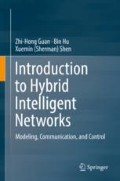Abstract
In sensor networks (SNs), how to allocate the limited resources so as to optimize data gathering and network utility is an important and challenging task. This chapter introduces a hybrid event-time-driven communication and updating scheme, with which sensor network optimization problems can be solved. A distributed hybrid driven optimization algorithm based on the coordinate descent method is presented. The proposed optimization algorithm differs from the existing ones since the hybrid driven scheme allows more choices of actuation time, resulting a tradeoff between communications and computation performance. Applying the proposed algorithm, each sensor node is driven in a hybrid event time manner, which removes the requirement of strict time synchronization. The convergence and optimality of the proposed algorithm are analyzed, and verified by simulation examples. The developed results also show the tradeoff between communications and computation performance.
Access this chapter
Tax calculation will be finalised at checkout
Purchases are for personal use only
References
J. A. Stankovic, “Research directions for the Internet of Things,” IEEE Internet Things J., vol. 1, no. 1, pp. 3–9, 2014.
J. Qin, Q. Ma, Y. Shi, and L. Wang, “Recent advances in consensus of multi-agent systems: A brief survey,” IEEE Trans. Ind. Electron., vol. 64, no. 6, pp. 4972–4983, 2017.
Y. Zhang, S. He, and J. Chen, “Data gathering optimization by dynamic sensing and routing in rechargeable sensor networks,” IEEE/ACM Trans. Netw., vol. 24, no. 3, pp. 1632–1646, 2016.
H. Gao, W. Zhan, H. R. Karimi, X. Yang, and S. Yin, “Allocation of actuators and sensors for coupled-adjacent-building vibration attenuation,” IEEE Trans. Ind. Electron., vol. 60, no. 12, pp. 5792–5801, 2013.
L. Zheng and L. Cai, “A distributed demand response control strategy using Lyapunov optimization,” IEEE Trans. Smart Grid, vol. 5, no. 4, pp. 2075–2083, 2014.
P. Wan and M. D. Lemmon, “Event-triggered distributed optimization in sensor networks,” in Proc. Int. Conf. Inf. Process. Sensor Netw. (IPSN ’09), 2009, pp. 49–60.
S. S. Ram, A. Nedic, and V. V. Veeravalli, “Incremental stochastic subgradient algorithms for convex optimization,” SIAM J. Optimization, vol. 20, no. 2, pp. 691–717, 2009.
G. Shi and K. H. Johansson, “Randomized optimal consensus of multi-agent systems,” Automatica, vol. 48, no. 12, pp. 3018–3030, 2012.
C. Eksin and A. Ribeiro, “Distributed network optimization with heuristic rational agents,” IEEE Trans. Signal Process., vol. 60, no. 10, pp. 5396–5411, 2012.
E. Wei and A. Ozdaglar, “Distributed alternating direction method of multipliers,” in Proc. 51st IEEE Conf. Decision Control, 2012, pp. 5445–5450.
D. P. Bertsekas, “Incremental proximal methods for large scale convex optimization,” Mathematical Program., vol. 129, no. 2, pp. 163–195, 2011.
L. Xiao and S. Boyd, “Fast linear iterations for distributed averaging,” Syst. & Contr. Lett., vol. 53, no. 1, pp. 65–78, 2004.
L. Carlone, V. Srivastava, F. Bullo, and G. C. Calafiore, “Distributed random convex programming via constraints consensus,” SIAM J. Contr. Optimization, vol. 52, no. 1, pp. 629–662, 2014.
C. G. Cassandras, “The event-driven paradigm for control, communication and optimization,” J. Contr. Decision, vol. 1, no. 1, pp. 3–17, 2014.
H. Li, X. Liao, T. Huang, and W. Zhu, “Event-triggering sampling based leader-following consensus in second-order multi-agent systems,” IEEE Trans. Autom. Control, vol. 60, no. 7, pp. 1998–2003, 2015.
W. Hu, L. Liu, and G. Feng, “Consensus of linear multi-agent systems by distributed event-triggered strategy,” IEEE Trans. Cybern., vol. 46, no. 1, pp. 148–157, 2016.
S. Wen, G. Guo, and W. S. Wong, “Hybrid event-time-triggered networked control systems: Scheduling-event-control co-design,” Inform. Sci., vol. 305, pp. 269–284, 2015.
D. V. Dimarogonas, E. Frazzoli, and K. H. Johansson, “Distributed event-triggered control for multi-agent systems,” IEEE Trans. Autom. Control, vol. 57, no. 5, pp. 2735–2750, 2012.
Z. H. Guan, B. Hu, M. Chi, D. X. He, and X. M. Cheng, “Guaranteed performance consensus in second-order multi-agent systems with hybrid impulsive control,” Automatica, vol. 50, no. 9, pp. 2415–2418, 2014.
S. S. Kia, J. Cortes, and S. Martinez, “Distributed convex optimization via continuous-time coordination algorithms with discrete-time communication,” Automatica, vol. 55, pp. 254–264, 2015.
B. Min and K. I. Goh, “Multiple resource demands and viability in multiplex networks,” Physical Review E, vol. 89, no. 4, pp. 040802, 2014.
K. W. Chang, C. J. Hsieh, and C. J. Lin, “Coordinate descent method for large-scale L2-loss linear support vector machines,” J. Machine Learn. Research, vol. 9, pp. 1369–1398, 2008.
P. Tseng, “Convergence of a block coordinate descent method for nondifferentiable minimization,” J. Optim. Theory Appl., vol. 109, no. 3, pp. 475–494, 2001.
C. Li, X. Yu, W. Yu, T. Huang, and Z. W. Liu, “Distributed event-triggered scheme for economic dispatch in smart grids,” IEEE Trans. Ind. Informat., vol. 12, no. 5, pp. 1775–1785, 2016.
J. Wu, Q. S. Jia, K. H. Johansson, and L. Shi, “Event-based sensor data scheduling: Trade-off between communication rate and estimation quality,” IEEE Trans. Autom. Control, vol. 58, no. 4, pp. 1041–1046, 2013.
H. Dong, Z. Wang, and H. Gao, “Distributed H∞ filtering for a class of Markovian jump nonlinear time-delay systems over lossy sensor networks,” IEEE Trans. Ind. Electron., vol. 60, no. 10, pp. 4665–4672, 2013.
M. Zhong and C. G. Cassandras, “Asynchronous distributed optimization with event-driven communication,” IEEE Trans. Autom. Control, vol. 55, no. 12, pp. 2735–2750, 2010.
D. P. Bertsekas and J. N. Tsitsiklis, Parallel and distributed computation: Numerical methods (Chapter 7 ), Belmont, MA: Athena Scientific, 1997.
X. Liu, Z. Gao, and M. Z. Q. Chen, “Takagi-Sugeno fuzzy model based fault estimation and signal compensation with application to wind turbines,” IEEE Trans. Ind. Electron., vol. 64, no. 7, pp. 5678–5689, 2017.
Author information
Authors and Affiliations
Rights and permissions
Copyright information
© 2019 Springer Nature Switzerland AG
About this chapter
Cite this chapter
Guan, ZH., Hu, B., Shen, X.(. (2019). Hybrid Event-Time-Driven Communication and Network Optimization. In: Introduction to Hybrid Intelligent Networks. Springer, Cham. https://doi.org/10.1007/978-3-030-02161-0_10
Download citation
DOI: https://doi.org/10.1007/978-3-030-02161-0_10
Published:
Publisher Name: Springer, Cham
Print ISBN: 978-3-030-02160-3
Online ISBN: 978-3-030-02161-0
eBook Packages: Computer ScienceComputer Science (R0)

